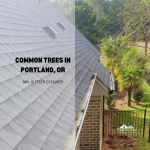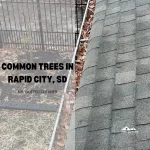In Eugene, OR, homeowners frequently encounter gutter blockages due to falling leaves and seed pods from common local trees. This natural debris accumulation necessitates regular gutter cleaning to maintain home functionality.
Deciduous trees, prevalent in Eugene, shed leaves seasonally, contributing significantly to gutter clogs.
Additionally, certain tree species produce seed pods that, alongside leaves, obstruct gutters, leading to potential water damage and structural issues. Regular gutter maintenance becomes crucial in preventing these problems, emphasizing the relationship between local flora and home upkeep.
This maintenance is not just about cleanliness; it’s a preventive measure against more serious, costly home repairs. Homeowners must understand the types of trees around their property and their specific maintenance challenges. Through this knowledge, they can effectively plan gutter cleaning schedules and techniques, ensuring their home’s longevity and safety.
The focus here is on integrating tree characteristics with practical home maintenance advice, offering homeowners in Eugene a comprehensive guide to managing this aspect of home care.
Why Do Some Trees in Eugene Drop Leaves and Seed Pods?
Eugene’s diverse climate triggers deciduous trees to shed leaves annually. This natural cycle, influenced by Eugene’s unique seasonal changes, leads to a significant fall of leaves. Specifically, the transition from warm summers to cooler autumns signals deciduous trees to conserve resources, resulting in leaf drop. This process, crucial for tree survival, poses challenges for homeowners in gutter maintenance.
Understanding Deciduous Trees in Eugene’s Climate
Deciduous trees in Eugene adapt to seasonal variations by shedding leaves. This adaptation, vital for conserving energy during colder months, aligns with Eugene’s temperate climate, characterized by distinct seasonal changes. Homeowners should note that this leaf fall is most pronounced in autumn, requiring increased attention to gutter cleaning during this period.
Table of Contents:
- Why Do Some Trees in Eugene Drop Leaves and Seed Pods?
- How Do Leaves and Seed Pods Affect Home Maintenance in Eugene?
- Identifying Trees That Cause the Most Gutter Problems
- The Importance of Regular Gutter Cleaning in Eugene
- Strategies for Managing Leaf and Seed Pod Fallout
- Professional vs. DIY Gutter Cleaning: What to Consider
- Additional Home Maintenance Tips Related to Trees
Seed Pod Production: What Triggers It in Local Trees?
Seed pod production in Eugene’s trees is predominantly influenced by the reproductive cycle of the species. In spring, many trees produce seed pods as part of their natural propagation process. Factors like light, temperature, and tree health play crucial roles in this cycle. These seed pods, often overlooked, can accumulate in gutters, necessitating thorough cleaning to prevent blockages.
How Do Leaves and Seed Pods Affect Home Maintenance in Eugene?
Leaves and seed pods from Eugene’s trees directly impact gutter functionality. Falling leaves and seed pods can clog gutters and downspouts, leading to water overflow and potential damage to a home’s foundation and exterior. Regular gutter cleaning becomes essential in Eugene, especially during autumn when leaf fall is at its peak. This preventive measure ensures water flows freely, protecting the home from water-related issues.
The Impact of Leaf Fall on Gutters
Leaf accumulation in gutters is a primary concern for homeowners in Eugene. Leaves, especially from broadleaf deciduous trees, tend to gather in gutters, obstructing water flow. This blockage can cause water to overflow, leading to potential damage to the roof, siding, and foundation. Homeowners need to be vigilant, particularly after the leaf-fall season, to clear their gutters, ensuring their home’s integrity.
Seed Pods and Gutter Blockages: A Common Issue
In addition to leaves, seed pods from various trees in Eugene contribute to gutter blockages. These pods, often smaller and more numerous, can slip into gutters and downspouts, creating clogs that are harder to detect and clear. Regular gutter inspection and cleaning are vital to prevent these subtle yet significant blockages. Homeowners should be aware of the types of trees around their property that produce these pods, as they can be a recurring source of gutter clogs.
Identifying Trees That Cause the Most Gutter Problems
In Eugene, specific trees are more likely to contribute to gutter blockages. These trees, mainly deciduous, are known for heavy leaf fall and seed pod production. Understanding which trees commonly lead to gutter problems aids homeowners in preemptive maintenance, reducing the risk of clogged gutters and associated damage.
Popular Eugene Trees Known for Leaf Drop
Eugene’s climate supports a variety of trees that shed significant amounts of leaves, particularly in autumn. Maple, Oak, and Birch are prime examples. Their broad leaves tend to accumulate quickly in gutters, necessitating more frequent cleaning during the fall season. Recognizing these species helps homeowners anticipate and prepare for the additional maintenance required.
Tree Species with Problematic Seed Pods
Certain trees in Eugene produce seed pods that can clog gutters and downspouts. Examples include Alder and Locust trees. Their smaller, numerous pods can easily slip into gutters, creating blockages that are often challenging to detect and remove. Homeowners should be aware of these species and consider their potential impact on gutter maintenance.
The Importance of Regular Gutter Cleaning in Eugene
Regular gutter cleaning is crucial in Eugene due to the leaf and seed pod fall from local trees. This maintenance task prevents gutter blockages, which can lead to water damage and compromise the structural integrity of a home. Timely gutter cleaning also enhances the efficiency of water drainage systems, ensuring they function properly during heavy rains.
Consequences of Neglecting Gutter Maintenance
Ignoring gutter maintenance can lead to severe consequences. Clogged gutters cause water overflow, which can damage the roof, walls, and foundation of a home. Additionally, the accumulated debris can attract pests and lead to mold growth. Regular cleaning, therefore, is not just about maintaining gutters but also about preserving the overall health of the home.
Best Practices for Gutter Cleaning and Maintenance
Effective gutter maintenance involves more than just removing debris. Homeowners should inspect gutters for signs of wear and tear, ensure downspouts are clear, and check for proper water flow. Utilizing tools like gutter scoops and high-pressure water hoses can make the cleaning process more efficient. It’s recommended to clean gutters at least twice a year, typically in the spring and fall, aligning with the shedding patterns of local trees.
Strategies for Managing Leaf and Seed Pod Fallout
Proactive measures are essential in managing the fallout from leaf and seed pod shedding in Eugene. Effective strategies include regular tree trimming and seasonal cleanup, which significantly reduce the risk of gutter clogs. These practices not only maintain gutter functionality but also contribute to the overall health and appearance of the property.
Effective Tree Trimming Techniques
Tree trimming, when done correctly, can minimize leaf and seed pod accumulation in gutters. Homeowners should focus on trimming branches that overhang the roof, as these are most likely to contribute to gutter blockages. It is advisable to undertake this task in late winter or early spring before the new growth begins. Employing proper pruning techniques ensures trees remain healthy and less prone to excessive shedding.
Seasonal Cleanup Tips for Homeowners
Seasonal cleanup, especially in autumn and spring, is vital in managing leaf and seed pod fallout. Homeowners should regularly clear their yards and roofs of fallen debris, preventing it from reaching the gutters. Using tools like leaf blowers and roof rakes can make this task more efficient. Additionally, installing gutter guards can be an effective way to prevent leaves and seed pods from entering the gutters, reducing the frequency of cleaning required.
Professional vs. DIY Gutter Cleaning: What to Consider
Choosing between professional and DIY gutter cleaning depends on various factors. Homeowners in Eugene must consider the extent of leaf and seed pod fallout, their personal ability to perform the task, and the complexity of their gutter systems. This decision is crucial in maintaining effective gutter functionality and preventing potential damage caused by tree debris.
When to Call a Professional for Gutter Cleaning
Professional gutter cleaning is recommended when the task is beyond the homeowner’s capability or when the gutter system is complex. Professionals have the necessary tools and expertise to handle challenging situations, such as high roofs or deeply clogged downspouts. Additionally, if the homeowner is not comfortable working at heights or lacks the appropriate equipment, hiring a professional is a safer and more efficient choice.
Tips and Tools for DIY Gutter Maintenance
For those who prefer DIY gutter cleaning, safety is paramount. Homeowners should use sturdy ladders, wear gloves, and employ tools like gutter scoops and garden hoses. It’s important to regularly check and clear the gutters, especially after heavy leaf fall or storms. However, if the task becomes overwhelming or risky, seeking professional help is advisable.
Additional Home Maintenance Tips Related to Trees
Beyond gutter cleaning, there are several other home maintenance aspects homeowners in Eugene should consider due to the presence of local trees. These additional measures are crucial in preventing long-term damage to properties, particularly in areas heavily populated with deciduous trees known for leaf and seed pod shedding.
Landscaping to Minimize Leaf and Seed Pod Issues
Effective landscaping can significantly reduce the volume of leaves and seed pods that end up in gutters. Homeowners should consider planting tree species less prone to heavy shedding or strategically placing trees to minimize the impact on their homes. Regular landscaping maintenance, such as pruning and leaf removal, also plays a vital role in keeping the property clean and reducing the need for gutter cleaning.
Regular Home Inspections: Preventing Long-Term Damage
Regular home inspections are vital in identifying early signs of damage caused by tree debris. These inspections should include checking the roof for accumulated leaves or seed pods, examining the siding for water damage, and ensuring the foundation is free from excessive moisture. By identifying and addressing these issues early, homeowners can avoid more extensive and costly repairs in the future.


